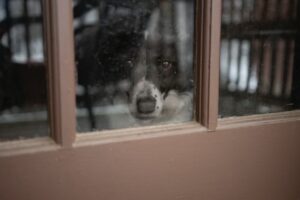Separation anxiety is a common behavioural problem in dogs that can be challenging to manage. It can be just as distressing for owners to leave their dog home alone for extended periods of time as it is for dogs, especially if the dog exhibits separation anxiety by barking, chewing furniture, destroying carpet or other objects, crying, or whining. We know that dogs are social animals who thrive on routine and consistency. Dogs are pack animals, so their domestication has led to a dependence on humans for food and shelter. Many dogs struggle with separation anxiety when left alone because it goes against their instincts as a pack animal.
This article looks at the common signs of separation anxiety, why dogs suffer from it and how pet owners can help their dogs cope better with being home alone.
How to tell if your dog is suffering from separation anxiety
Some common signs your dog will display if they are suffering from separation anxiety may include the following:
- Excessive barking, crying or whining – you may have heard your dog start to bark when you leave the house or your neighbours might have complained about the noise. If your dog is stressed, it may also howl or whine and potentially continue to do so until you arrive back home.
- Destructive behaviour – if your dog is highly anxious, they might engage in destructive behaviour as a way of coping with their stress. These behaviours may include chewing on furniture, carpets, shoes and other household items, or scratching on doors and window sills.
- Pacing – stressed dogs may walk around in circles or pace around when they’re feeling restless or when they know their owner is about to leave them.
- Drooling or panting excessively – excessive drooling and panting can be triggered by anxiety.
- Doing their business indoors – even if your dog is housetrained, they may pee or poop in the house if they feel anxious or upset.
You may not be aware of all or in fact any of the above signs when you’re not at home to witness them, but there are some signs of separation anxiety to take note of when you are at home. For example, you may notice your dog being extra needy, wanting to be close to you and seeking lots of attention, following you around all over the house, or becoming very quiet and giving you the sad eyes when they sense you’re about to leave.
Why do dogs suffer from separation anxiety?
Some dogs get anxious when you leave because they feel like they’ve been left behind. They may feel like they’re not part of the family or like they are being punished for something. Other dogs might become anxious about being left alone. They might get bored and restless or feel uncertain about what will happen next.
Some pups are more prone to separation anxiety than others due to past traumas they have experienced, or they may have abandonment issues if they are used to always having people around or had a bad experience with being left alone in the past. Different personality types can also play a part with some dogs being generally more needy and clingy than others.
 Dogs are very sensitive animals and they react to changes in their routine and environment. Things like changing your work routine, not being at home as much as usual, moving house, losing a family member, or any other big life changes are all triggers for your dog becoming more anxious when left alone.
Dogs are very sensitive animals and they react to changes in their routine and environment. Things like changing your work routine, not being at home as much as usual, moving house, losing a family member, or any other big life changes are all triggers for your dog becoming more anxious when left alone.
Now that pet owners are starting to go back to the office/workplace post-pandemic, our dogs are having to adapt to our change in routines yet again. This has resulted in many pups struggling with separation anxiety due to a lack of socialisation and exposure during the pandemic lockdowns and others are fearful of being away from their owners and being home alone for longer periods of time than they have been used to.
Is it more about us or them?
Like many behavioural issues in dogs, helping your dog overcome their anxiety is often more about modifying your own behaviour as a pet owner. The dog-human relationship is a complex one and often we need them as much as they need us. We shower them with love and affection and endless pats, cuddles and attention, but then when we leave, the dog doesn’t have the skills needed to feel safe and secure without you until you return home.
Dogs need structure, routine and consistency in their daily lives and as much as we love to be with our dog when we are home it’s important to create boundaries and have times when you are separated from your dog when you are at home. Designating set times to spend without your dog whilst at home will help them to gain a sense of independence.
It comes down to training your dog to get used to being alone and helping them to feel more comfortable when you’re not around.
So how can we help our dogs to feel safe when we leave the house?
Below are some ways to help your dog overcome their anxiety and fear of being left alone.
- Don’t make your dog feel more anxious than they already do. If your dog is experiencing anxiety when you leave, it’s important to find a way to ease that anxiety. If you leave your dog in a high-stress environment without addressing the root of their anxiety, they may be more likely to act out, bark, or chew things. Don’t punish your dog for showing signs of anxiety, as this will likely make the situation worse and will only make them feel more fearful. Also, make sure you are not rewarding the behaviour you are trying to discourage, so if your dog is barking, crying or displaying any of the common signs of anxiety, don’t give them a treat as a way of making them feel better as this will prolong the behaviour.
- Give your dog something to look forward to when you go. When you leave your dog at home, you want to make sure they have plenty to do and something to look forward to. Dogs, like people, need a variety of enrichment activities to keep them engaged and happy. Give your dog something to do when you’re away, like dog puzzles and toys that are designed to challenge their brains, or perhaps a bone or chew toy. Your dog will appreciate the chance to be active and engaged when you’re not there, and it will be a good way to help them deal with their anxiety.
- Help your dog build confidence and independence. When a dog experiences anxiety, they may be left feeling uncertain, insecure, and clingy. Dogs with separation anxiety may want to follow you around the house or stay close to you when you’re with them but dog experts recommend that you create opportunities for your dog to demonstrate their independence when you are at home. You can help your dog become more independent by giving them something to do, like a puzzle or challenging training, or by giving them a job to do, like helping you sort the mail or bring in the groceries. Set boundaries by not spending all your time with your dog when you’re at home, and create space by spending some of your time in a separate room of the house where your dog can’t see you. Create a consistent routine of when you interact and don’t interact with your dog, so for example, have set times for play, walks and cuddles, and other times for doing your own thing separate from your dog.
Separation anxiety is something that many dogs experience at some point in their lives, but that doesn’t mean it has to be a problem. If you can make your dog feel safe and secure, and provide them with things to look forward to when you leave the house, they are more likely to feel more confident and independent when you aren’t there. If separation anxiety is a problem for your dog, it’s important to seek advice and support from your veterinarian.